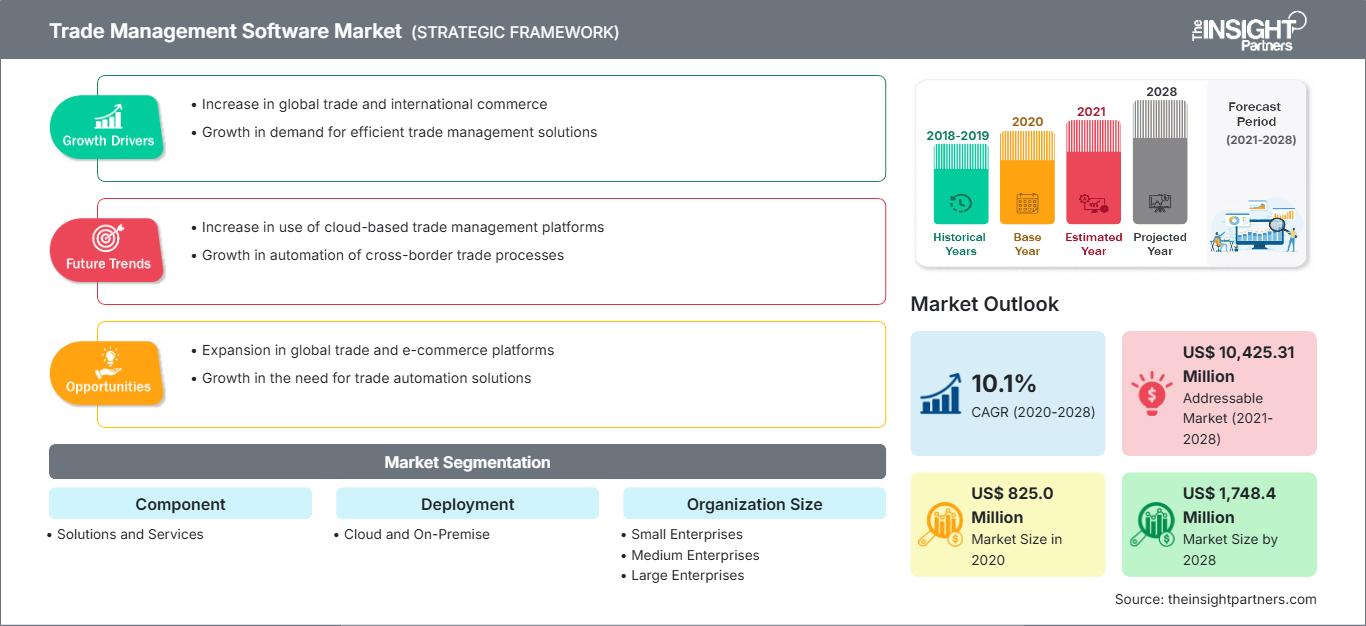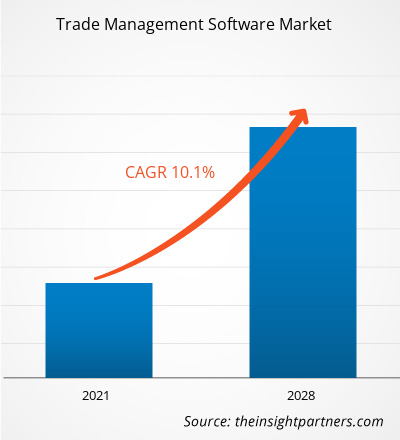[Forschungsbericht]Der globale Markt für Handelsmanagement-Software hatte im Jahr 2020 einen Umsatz von 825,0 Millionen US-Dollar und soll bis 2028 1.748,4 Millionen US-Dollar erreichen. Im Prognosezeitraum 2020–2028 wird ein CAGR-Wachstum von 10,1 % erwartet.
Der Markt für Handelsmanagement-Software ist grob in fünf Hauptregionen unterteilt: Nordamerika, Europa, APAC, MEA und SAM. Die APAC-Region dominierte den Markt für Handelsmanagement-Software im Jahr 2020. APAC besteht aus vielen Entwicklungsländern mit hohem Wachstum in ihrem jeweiligen Fertigungssektor. Die Region hat sich zu einem globalen Produktionszentrum entwickelt. China und andere Entwicklungsländer wie Indien, Südkorea, Taiwan und Vietnam ziehen zahlreiche Unternehmen an, die ihre Produktionsstätten für gering- bis mittelqualifizierte Arbeitskräfte in Nachbarländer verlagern, wo die Arbeitskräfte günstiger sind. Darüber hinaus unternehmen die Regierungen dieser Länder Anstrengungen, um ausländische Investitionen in der Region zu fördern. Im Laufe der Jahre sind die Produktionsausgaben der Region erheblich gestiegen und es wird erwartet, dass sie auch weiterhin mit einer ordentlichen Wachstumsrate wachsen. Dieses dramatische Wachstum der Produktionsausgaben und die Einführung neuer Technologien sind die Hauptfaktoren, die die Nachfrage nach Handelsmanagementsoftware in der Region ankurbeln.
Auswirkungen der COVID-19-Pandemie auf den Markt für Handelsmanagementsoftware
Die COVID-19-Pandemie beeinträchtigt seit Dezember 2019 alle Unternehmen weltweit. Der kontinuierliche Anstieg der Zahl virusinfizierter Patienten zwang Regierungen, den Transport von Menschen und Gütern einzuschränken. Der Fertigungssektor verzeichnete aufgrund vorübergehender Fabrikschließungen und geringer Produktionsmengen schwere Verluste, was das Wachstum des Einzelhandels-, E-Commerce- und Logistiksektors behinderte. Darüber hinaus haben die von den Regierungen verhängten sozialen oder physischen Distanzierungsmaßnahmen die Geschäftstätigkeit von Logistik- und anderen Dienstleistern eingeschränkt. Diese Störung hat zu einem Rückgang des Handelsgeschäfts geführt. Diese Widrigkeiten führten im Mai 2020 zu einem Rückgang des globalen Handelsvolumens um 17,7 % im Vergleich zum Handelsvolumen im Mai 2019. Der Rückgang in den ersten fünf Monaten des Jahres 2020 war durchdringend und beeinträchtigte insbesondere die Exporte aus Japan, den USA und europäischen Ländern. Trotz der durch die COVID-19-Pandemie verursachten Störungen wird der Handel in Zukunft voraussichtlich wieder anziehen, da die Unternehmen nach einem langen Lockdown ihre Arbeit wieder aufnehmen. Angesichts der geltenden Maßnahmen zur sozialen Distanzierung konzentrieren sich E-Commerce, Logistik, Einzelhandel und andere am Handel beteiligte Sektoren auf die Einführung von Handelsmanagement-Software, um die Compliance durch die Gewährleistung schneller Lieferketten zu gewährleisten. Die durch COVID-19 verursachten Unsicherheiten haben daher den Anwendungsbereich von Cloud-basierter Software/SaaS in der Logistik erweitert.
Passen Sie diesen Bericht Ihren Anforderungen an
Sie erhalten kostenlos Anpassungen an jedem Bericht, einschließlich Teilen dieses Berichts oder einer Analyse auf Länderebene, eines Excel-Datenpakets sowie tolle Angebote und Rabatte für Start-ups und Universitäten.
Markt für Handelsmanagementsoftware: Strategische Einblicke

- Holen Sie sich die wichtigsten Markttrends aus diesem Bericht.Dieses KOSTENLOSE Beispiel umfasst Datenanalysen, die von Markttrends bis hin zu Schätzungen und Prognosen reichen.
Markteinblicke – Kostensenkung und Echtzeit-Transparenz im Markt für Handelsmanagement-Software
Sie erhalten kostenlos Anpassungen an jedem Bericht, einschließlich Teilen dieses Berichts oder einer Analyse auf Länderebene, eines Excel-Datenpakets sowie tolle Angebote und Rabatte für Start-ups und Universitäten.
Markt für Handelsmanagementsoftware: Strategische Einblicke

- Holen Sie sich die wichtigsten Markttrends aus diesem Bericht.Dieses KOSTENLOSE Beispiel umfasst Datenanalysen, die von Markttrends bis hin zu Schätzungen und Prognosen reichen.
Handel ist ein komplexer Prozess, der den Fluss vielfältiger Güter und Informationen über ein Netzwerk aus Lieferanten, Spediteuren und Lagern umfasst. Softwarelösungen helfen Anwendern, diese Komplexität durch die Analyse von Echtzeit- und Realweltdaten präziser und einfacher zu bewältigen und so Ineffizienzen zu reduzieren. Die Implementierung dieser Softwaresysteme verbessert zudem die Funktionsweise der Lieferkette und bietet Echtzeit-Transparenz in den Betriebsabläufen. Die zunehmende Wettbewerbsfähigkeit in verschiedenen Branchen ist ein wichtiger Faktor, der sie zu Investitionen in Automatisierung und Digitalisierung zwingt. Darüber hinaus bietet die Einführung cloudbasierter Lösungen eine verbesserte Echtzeit-Transparenz der exportierten Güter und senkt die Betriebskosten. Die Implementierung neuer Technologien wie Blockchain, künstlicher Intelligenz (KI) und prädiktiver Analyse in der Logistik wird das Wachstum des globalen Marktes für Handelsmanagement-Software in den kommenden Jahren weiter ankurbeln.
Einblicke in Komponentensegmente
Basierend auf den Komponenten ist der Markt für Handelsmanagement-Software in Lösungen und Dienstleistungen unterteilt. Das Segment Lösungen wird im Prognosezeitraum voraussichtlich das führende Segment im globalen Markt für Handelsmanagement-Software sein. Das Segment Lösungen umfasst Handelskonformität sowie Transparenz und Abwicklung des internationalen Handels. Darüber hinaus umfasst die Transparenz und Abwicklung des internationalen Handels grenzüberschreitenden Versand und Transport. Sie bietet Einblick in Ereignisse und Prozesse internationaler Handelspartner. Diese Prozesse müssen international sein und Transaktionen und Vereinbarungen zwischen kommerziellen Handelspartnern umfassen.
Einblicke in das Segment Bereitstellung
Basierend auf der Bereitstellung ist der Markt für Handelsmanagement-Software in On-Premise und Cloud segmentiert. Das Cloud-Segment wird im Prognosezeitraum voraussichtlich das führende Segment im globalen Markt für Handelsmanagement-Software sein. Die Cloud-Bereitstellung wird hauptsächlich von kleinen und mittleren Unternehmen genutzt. Niedrige Betriebskosten, geringere Kosten für Wartung und Upgrades sowie der Zugriff auf die neuesten Funktionen gehören zu den Hauptvorteilen der Cloud-Bereitstellung gegenüber der On-Premise-Bereitstellung.
Einblicke in das Segment Unternehmensgröße
Basierend auf der Unternehmensgröße ist der Markt für Handelsmanagement-Software in kleine, mittlere und große Unternehmen segmentiert. Das Segment der großen Unternehmen wird im Prognosezeitraum voraussichtlich das führende Segment im globalen Markt für Handelsmanagement-Software sein. Weltweit steigt die Nachfrage nach Handelsmanagement-Software bei verschiedenen Organisationen, um die Effizienz zu steigern und die Gesamtbetriebskosten zu minimieren. Der Einsatz dieser Software ist bei großen Unternehmen gängige Praxis, um eine geeignete Lieferkette aufzubauen und die Gesamtbetriebsflexibilität zu erhöhen.
Branchensegment-Einblicke
Branchenbezogen wird erwartet, dass das Segment Logistik und Transport im Prognosezeitraum das führende Segment im globalen Markt für Handelsmanagement-Software sein wird. Die Nachfrage nach Logistikanbietern, die über traditionelle Dienstleistungen hinausgehen, steigt. In einigen Fällen betreiben oder verwalten externe Logistikanbieter Außenhandelszonen ihrer Partner. In anderen Fällen bieten sie Lagerhaltung sowie Mehrwertdienste im Zusammenhang mit der Produktion oder Beschaffung von Waren an. Darüber hinaus organisieren sie alle Logistik- und Transportprozesse, die für einen effizienten und wirtschaftlichen Warentransport vom Ursprungsort zum Endverbraucher unerlässlich sind.
Die Marktteilnehmer konzentrieren sich auf Produktinnovationen und -entwicklungen, indem sie fortschrittliche Technologien und Funktionen in ihre Produkte integrieren, um mit der Konkurrenz mithalten zu können.
- Im Januar 2021 schlossen sich SAP Hong Kong und das Beratungsunternehmen Deloitte zusammen, um Unternehmen im grenzüberschreitenden Handel erhebliche Vorteile zu bieten.
- Im Januar 2019 führte Bamboo Rose seine Dienste als Abonnementmodell ein, das Kunden dabei hilft, besser zu planen, Innovationen zu entwickeln und mit ihren unternehmensübergreifenden Einzelhandelsgemeinschaften zusammenzuarbeiten, wodurch sie 10 bis 30 Prozent ihrer Technologieinvestitionen einsparen können.
- Im März 2019 übernahm Thomson Reuters den Global Trade Management (GTM)-Softwareanbieter Integration Point für einen nicht genannten Betrag. Dadurch erweitert Thomson Reuters seinen Kundenstamm an nordamerikanischen Importeuren und Exporteuren erheblich.
Handelsmanagement-SoftwareRegionale Einblicke in den Markt für Handelsmanagementsoftware
Die Analysten von The Insight Partners haben die regionalen Trends und Faktoren, die den Markt für Handelsmanagement-Software im Prognosezeitraum beeinflussen, ausführlich erläutert. In diesem Abschnitt werden auch die Marktsegmente und die geografische Lage in Nordamerika, Europa, dem asiatisch-pazifischen Raum, dem Nahen Osten und Afrika sowie Süd- und Mittelamerika erörtert.
Umfang des Marktberichts zur Handelsmanagementsoftware
| Berichtsattribut | Einzelheiten |
|---|---|
| Marktgröße in 2020 | US$ 825.0 Million |
| Marktgröße nach 2028 | US$ 1,748.4 Million |
| Globale CAGR (2020 - 2028) | 10.1% |
| Historische Daten | 2018-2019 |
| Prognosezeitraum | 2021-2028 |
| Abgedeckte Segmente |
By Komponente
|
| Abgedeckte Regionen und Länder | Nordamerika
|
| Marktführer und wichtige Unternehmensprofile |
|
Dichte der Marktteilnehmer für Handelsmanagementsoftware: Verständnis ihrer Auswirkungen auf die Geschäftsdynamik
Der Markt für Handelsmanagement-Software wächst rasant. Dies wird durch die steigende Endverbrauchernachfrage aufgrund veränderter Verbraucherpräferenzen, technologischer Fortschritte und eines stärkeren Bewusstseins für die Produktvorteile vorangetrieben. Mit der steigenden Nachfrage erweitern Unternehmen ihr Angebot, entwickeln Innovationen, um den Bedürfnissen der Verbraucher gerecht zu werden, und nutzen neue Trends, was das Marktwachstum weiter ankurbelt.

- Holen Sie sich die Markt für Handelsmanagementsoftware Übersicht der wichtigsten Akteure
- Lösung
- Dienste
Markt für Handelsmanagementsoftware – nach Bereitstellung
- Vor Ort
- Cloud
Markt für Handelsmanagementsoftware – nach Unternehmensgröße
- Großunternehmen
- Mittelständische Unternehmen
- Kleine Unternehmen
Markt für Handelsmanagementsoftware – nach Endbenutzer
- Einzelhandel & CG
- Automobil
- Logistik und Transport
- Gesundheitswesen und Pharma
- Regierung
- Luft- und Raumfahrt und Verteidigung
- Chemie und Mineralien
- Fertigung
- Sonstige
Markt für Handelsmanagement-Software – nach Region
Nordamerika
- USA
- Kanada
- Mexiko
Europa
- Frankreich
- Deutschland
- Italien
- Großbritannien
- Russland
- Restliches Europa
Asien-Pazifik (APAC)
- China
- Indien
- Südkorea
- Japan
- Australien
- Restlicher APAC
Naher Osten und Afrika (MEA)
- Südafrika
- Saudi-Arabien
- VAE
- Rest von MEA
Südamerika (SAM)
- Brasilien
- Argentinien
- Rest von SAM
Handelsmanagement-Softwaremarkt – Unternehmensprofile
- Amber Road, Inc.
- Bamboo Rose LLC
- Expeditors International of Washington, Inc.
- Integration Point, LLC
- Livingston International
- MIC
- Oracle Corp
- QAD, Inc
- QuestaWeb
- SAP SE
- Historische Analyse (2 Jahre), Basisjahr, Prognose (7 Jahre) mit CAGR
- PEST- und SWOT-Analyse
- Marktgröße Wert/Volumen – Global, Regional, Land
- Branchen- und Wettbewerbslandschaft
- Excel-Datensatz
Aktuelle Berichte
Verwandte Berichte
Erfahrungsberichte
Grund zum Kauf
- Fundierte Entscheidungsfindung
- Marktdynamik verstehen
- Wettbewerbsanalyse
- Kundeneinblicke
- Marktprognosen
- Risikominimierung
- Strategische Planung
- Investitionsbegründung
- Identifizierung neuer Märkte
- Verbesserung von Marketingstrategien
- Steigerung der Betriebseffizienz
- Anpassung an regulatorische Trends




















 Kostenlose Probe anfordern für - Markt für Handelsmanagementsoftware
Kostenlose Probe anfordern für - Markt für Handelsmanagementsoftware